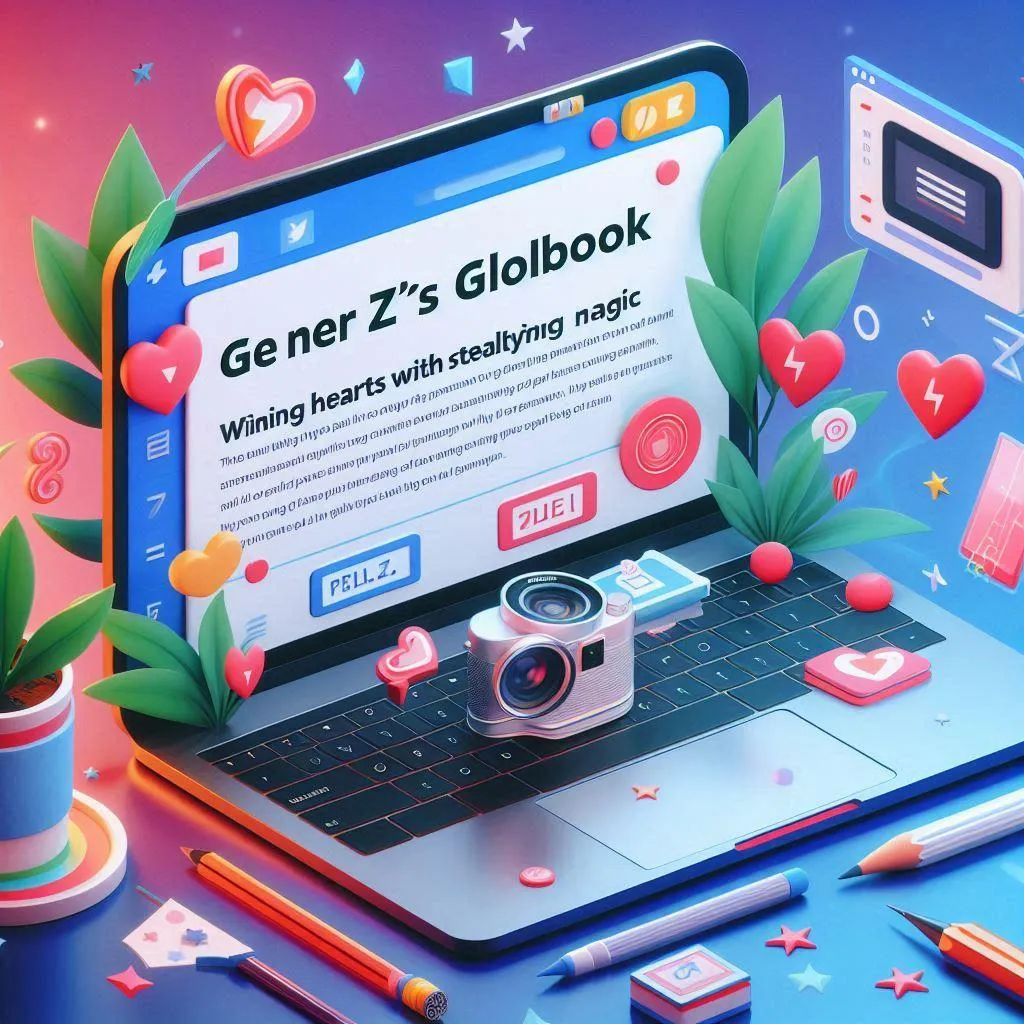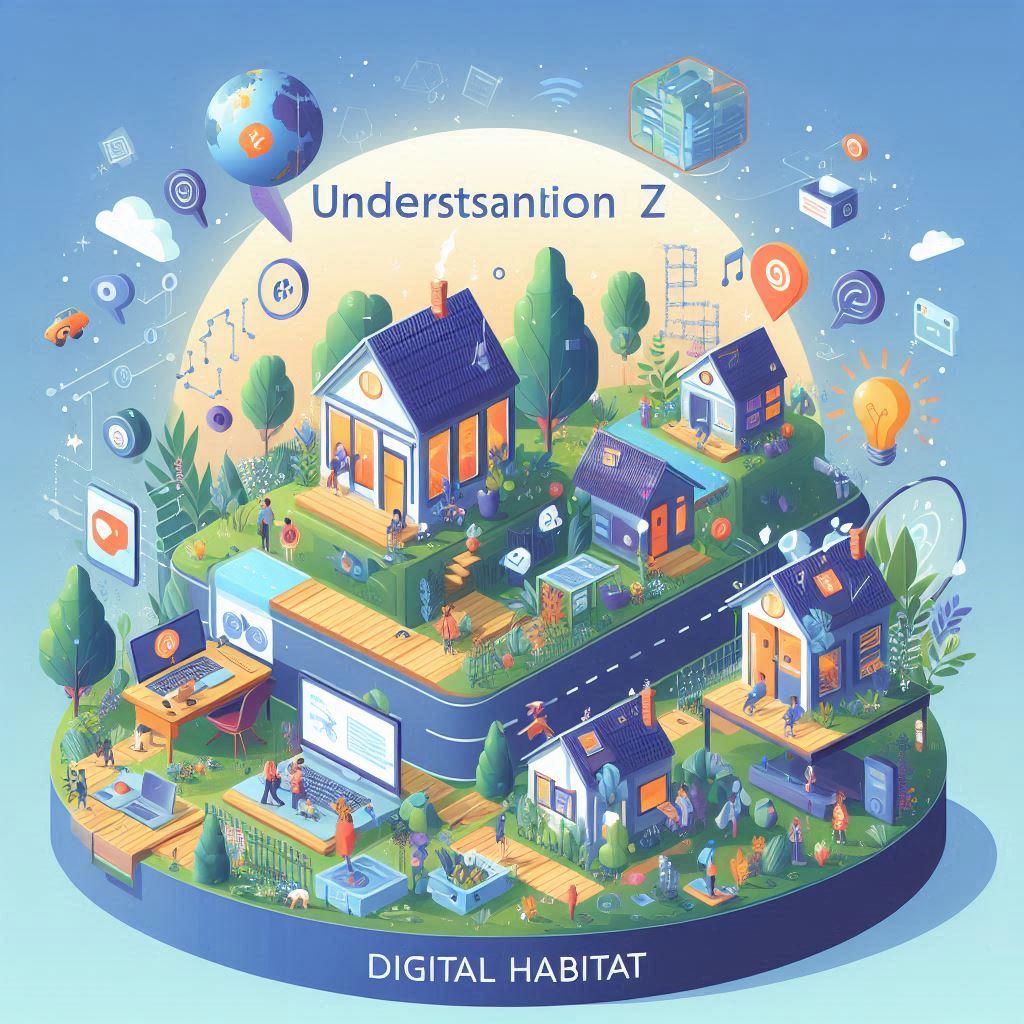Blog

Engage the Next Wave: Crafting Native Ad Narratives for Gen Z Connection
Understanding Gen Z's Digital Habitat
In the vast expanse of the digital age, one generation stands out for its unique upbringing amidst the buzz and whirl of the internet and social media: Generation Z. Born between the mid-1990s and the early 2010s, this demographic has not known a world without the internet, making them the first true digital natives. Their digital habitat is rich, complex, and ever-evolving, setting them apart in how they interact with content, brands, and each other.
The Digital First Approach
For Gen Z, digital platforms are not just tools or channels for communication; they are integral parts of their daily lives. Social media, in particular, plays a central role, serving as a space for connection, expression, and entertainment. Among the plethora of platforms, Instagram, TikTok, and Snapchat emerge as the leaders in capturing the attention and engagement of this generation. Each platform, with its unique features and user experience, caters to the diverse interests and preferences of Gen Z users, from visual storytelling and instant updates to creative and interactive content.
Shaping Expectations
The immersion of Gen Z in these digital platforms has significantly shaped their expectations for the content they consume. Unlike previous generations, they look for authenticity and creativity, preferring content that feels personal, genuine, and engaging. This craving for authenticity extends to their interactions with brands, where they favor those that demonstrate social responsibility, inclusivity, and environmental sustainability. For Gen Z, the value of content and brand messaging lies not just in the product being sold but in the story being told and the impact it makes.
The Role of Platforms
Each social media platform offers a unique environment that influences how Gen Z perceives and interacts with content. Instagram, with its visually rich interface, is the go-to for aesthetic inspiration and brand discovery. TikTok, known for its short-form videos, thrives on creativity, humor, and trends, making it a powerhouse for viral content. Snapchat, with its ephemeral messages, offers a more intimate and spontaneous way of connecting, appealing to the desire for genuine interaction. Understanding these platforms' nuances is crucial for creating content that resonates with the Gen Z audience.
Authenticity, Creativity, and Social Responsibility
The digital habitat of Gen Z is one where authenticity, creativity, and social responsibility reign supreme. To engage this generation effectively, content creators and brands must align with these values. This means moving beyond traditional advertising tactics and embracing a more genuine and creative approach to storytelling. It involves highlighting diversity, championing inclusivity, and taking a stand on social and environmental issues. By doing so, brands can not only capture the attention of Gen Z but also earn their trust and loyalty.
Setting the Stage

As we delve deeper into the intricacies of reaching and engaging Gen Z, it's clear that understanding their digital habitat is just the beginning. The platforms they frequent and the content they prefer lay the foundation for a new era of digital engagement. Through this lens, we can see the immense potential of native advertising and authentic connections in not just capturing Gen Z's attention but also in fostering a deeper, more meaningful relationship with them. As we explore these concepts further in the following sections, keep in mind the digital-first, authenticity-driven world that Gen Z inhabits. It's not just about reaching them where they are but understanding who they are and what they value, setting the stage for a new paradigm in digital marketing and brand engagement.
In this digital-first landscape, the challenge for brands and marketers is clear: adapt and evolve to meet Gen Z on their terms, in their habitat, speaking their language. The journey through Gen Z's digital world is one of discovery, creativity, and connection, offering a roadmap for those willing to engage with the architects of tomorrow's digital landscape.
The Power of Native Advertising
In the intricate digital ecosystem where Generation Z thrives, native advertising emerges as a beacon of modern marketing strategy. This form of advertising, designed to blend seamlessly with the user's online experience, holds a particular resonance with a demographic that prizes authenticity and creativity above all. Native ads, by mimicking the look, feel, and function of the content surrounding them, present an opportunity to engage with Gen Z on their own turf, speaking their language in a way that feels both natural and engaging.
Defining Native Advertising
At its core, native advertising is about subtlety and integration. Unlike traditional ads that disrupt the user experience, native ads weave into the digital landscape, offering content that is not only relevant but also adds value to the viewer's experience. This can range from sponsored posts on social media feeds to recommended content on a web page. The key is that these ads do not feel like ads at all. For Gen Z, a generation adept at navigating the digital realm and wary of overt marketing tactics, this approach is not just preferable; it's expected.
Overcoming Skepticism with Engagement
Gen Z's skepticism towards traditional advertising is well-documented. Bombarded with information from a young age, they have developed a discerning eye that can spot and dismiss insincere content with ease. Native advertising, when executed with care and creativity, can circumvent this skepticism. By offering content that is genuinely interesting, entertaining, or informative, brands can engage Gen Z without the resistance often encountered with more conventional advertising methods.
Examples of Success
Consider the impact of a well-crafted sponsored post on Instagram that aligns with the aesthetic and tone of the influencer sharing it. Or a TikTok challenge sponsored by a brand that becomes a viral sensation, engaging users in a way that feels spontaneous and fun. These examples highlight the potential of native advertising to integrate into the digital habits of Gen Z, fostering a connection that feels both organic and meaningful.
The Value Exchange
The success of native advertising with Gen Z hinges on a clear value exchange. This demographic is not opposed to advertising per se but to advertising that offers them nothing in return. They understand the commercial realities of the digital world but expect brands to contribute positively to their online experience. Whether it's through entertainment, information, or a sense of community, native ads must enrich the user's experience to be welcomed into Gen Z's digital habitat.
Setting the Stage for Authentic Engagement
As we delve deeper into the nuances of engaging Gen Z, the role of native advertising becomes increasingly clear. It's not just a tool for circumventing ad blockers or the diminishing attention spans of younger audiences. It's a pathway to authentic engagement in a landscape where sincerity, creativity, and social responsibility are paramount. By embracing the principles of native advertising, brands have the opportunity to not just reach Gen Z but to resonate with them on a level that transcends traditional marketing paradigms.
In navigating the digital world of Generation Z, native advertising stands out not as a mere tactic, but as a vital strategy for meaningful engagement. As we move forward, the challenge for brands and marketers is to harness the power of this approach, crafting content that speaks directly to the hearts and minds of the most digitally savvy generation yet. The journey into Gen Z's digital habitat is complex, but with native advertising, the path to genuine connection is clear.
Crafting Authentic Connections
In the digital age, where Generation Z navigates through a sea of content and advertisements, crafting authentic connections becomes the cornerstone of successful marketing. This section delves into the essence of building genuine relationships with Gen Z through native advertising, emphasizing the integration of their core values—diversity, inclusivity, and environmental sustainability—into marketing strategies. Here, we explore how brands can leverage storytelling, user-generated content, and influencer partnerships to create native ads that resonate deeply with Gen Z audiences, ultimately capturing their attention and earning their trust.
Embracing Gen Z Values
Understanding and embracing the values important to Gen Z is the first step toward crafting authentic connections. This generation is not just a consumer group; they are advocates for change, champions of diversity, and guardians of the planet. They seek brands that mirror these values and are willing to take a stand on social issues. Therefore, integrating these principles into native advertising content is not just beneficial; it's imperative. For instance, a campaign highlighting the brand's commitment to reducing its carbon footprint or its efforts in promoting diversity within its organization can strike a chord with Gen Z consumers, fostering a sense of shared values and purpose.
Storytelling That Resonates
Storytelling is a powerful tool in the marketer's arsenal, particularly when targeting a generation that values authenticity and creativity. Effective storytelling in native advertising involves crafting narratives that are relatable, inspiring, and reflective of Gen Z's experiences and aspirations. It's about moving beyond product features and benefits to tell stories that evoke emotions and provoke thought. Whether it's a short video on TikTok showcasing the journey of a product from conception to completion or a series of Instagram posts highlighting customer stories, storytelling can transform a native ad from a mere promotion to a piece of content that Gen Z wants to engage with and share.
Leveraging User-Generated Content
User-generated content (UGC) is another powerful strategy for creating authentic connections with Gen Z. This demographic values the opinions and experiences of their peers far more than traditional advertising messages. Encouraging and leveraging UGC in native advertising not only amplifies authenticity but also fosters a sense of community and belonging. Brands can initiate hashtag challenges, user contests, or invite product reviews and stories, integrating these genuine voices into their marketing campaigns. This approach not only enhances the credibility of the brand but also provides a platform for Gen Z to express themselves and participate in brand storytelling.
Influencer Partnerships with Purpose
Influencer marketing, when aligned with the principles of native advertising, can significantly boost a brand's authenticity and appeal among Gen Z. However, the key lies in partnering with influencers who genuinely resonate with the brand's values and have a genuine connection with their audience. These partnerships should go beyond mere product endorsements, focusing instead on co-creating content that is meaningful, relevant, and engaging. By collaborating with influencers on campaigns that highlight social causes, sustainability efforts, or inclusive initiatives, brands can tap into the influencer's credibility and reach, creating content that feels both personal and impactful.
Conclusion
As we navigate the complexities of marketing to Gen Z, it becomes evident that authenticity is not just a buzzword but the foundation of building lasting connections. In the realm of native advertising, this means creating content that is true to the brand's values, resonates with Gen Z's ideals, and engages them in a conversation rather than a one-sided promotion. By focusing on storytelling, leveraging user-generated content, and forming meaningful influencer partnerships, brands can craft native ads that not only capture attention but also cultivate trust and loyalty among the most digitally savvy generation yet. As we move forward, the brands that succeed will be those that view their relationship with Gen Z not as a target demographic to be marketed to but as partners in a shared journey toward a better future.
Leveraging Social Media Nuances

In the dynamic digital world that Generation Z inhabits, understanding the subtle differences between social media platforms is crucial for tailoring native advertising strategies that resonate. Each platform, from TikTok and Instagram to Snapchat, has its own culture, language, and set of user behaviors, making a one-size-fits-all approach ineffective. This section explores how brands can leverage these nuances to create native advertising campaigns that not only capture attention but also spark engagement and sharing among Gen Z users.
TikTok: Creativity and Virality
TikTok stands out for its unique blend of creativity, humor, and musicality, making it a fertile ground for native advertising that doesn't feel like advertising. Successful campaigns on TikTok often involve challenges or trends that encourage user participation, turning passive viewers into active creators. For instance, a brand can initiate a hashtag challenge that aligns with its values or product offerings, inviting users to create their own content under this hashtag. This not only amplifies the brand's message but also leverages the power of user-generated content, making the campaign feel more authentic and grassroots.
Instagram: Aesthetic Appeal and Storytelling
Instagram's visually rich platform is perfect for brands that want to tell their story through compelling images and videos. The key to engaging Gen Z on Instagram is through high-quality, aesthetically pleasing content that fits seamlessly into their curated feeds. Brands can utilize Instagram Stories and Reels to showcase behind-the-scenes content, product launches, or customer stories in a more casual and relatable manner. The use of appropriate hashtags and collaborations with influencers who embody the brand's aesthetic can further enhance the reach and impact of native advertising on Instagram.
Snapchat: Ephemeral Content and Intimacy
Snapchat's ephemeral nature encourages a level of spontaneity and intimacy not found on other platforms. Brands can tap into this by creating native ads that feel like a natural part of the user's daily story viewing. Exclusive offers, sneak peeks, or interactive polls can make Gen Z users feel like they are part of an exclusive club, increasing engagement and loyalty. Moreover, Snapchat's location-based features offer opportunities for localized marketing efforts, connecting with users based on their real-world activities and interests.
Tailoring Content to Platform-Specific Trends
Beyond understanding the core features of each platform, successful native advertising requires keeping a finger on the pulse of current trends and memes. What goes viral on TikTok might not resonate on Instagram, and vice versa. Brands need to be nimble, adapting their content to fit not just the platform but also the evolving cultural context of Gen Z's digital world. This might involve tapping into current slang, music, or social movements, ensuring the content is timely and relevant.
Engagement Tactics: Beyond the Post
Engagement doesn't end with posting content. Gen Z values interaction, making it essential for brands to actively engage with comments, shares, and direct messages. This two-way communication fosters a sense of community and belonging, key elements in building loyalty among Gen Z consumers. Additionally, leveraging analytics tools to track engagement and adjust strategies in real time can help brands stay ahead in the fast-paced social media landscape.
Conclusion
The nuances of social media platforms offer a rich tapestry for brands to craft native advertising that resonates with Generation Z. By understanding and leveraging the unique characteristics and user behaviors of platforms like TikTok, Instagram, and Snapchat, brands can create campaigns that are not only engaging but also deeply integrated into the fabric of Gen Z's digital lives. The key lies in creativity, adaptability, and a genuine commitment to interaction and engagement, paving the way for not just temporary attention but lasting brand loyalty. As we move forward, the brands that succeed will be those that view their engagement with Gen Z not as a series of ad campaigns but as an ongoing conversation, evolving with the digital landscape and the young people who are shaping its future.
Measuring Success and Fostering Loyalty
In the rapidly evolving digital landscape that Generation Z calls home, the effectiveness of native advertising campaigns and the cultivation of brand loyalty emerge as critical indicators of success. This final section underscores the importance of evaluating the impact of native ads on Gen Z and outlines strategies for transforming fleeting engagements into enduring relationships. By leveraging the insights gained from the preceding sections, brands can navigate the complexities of the digital world with confidence, ensuring their messages resonate with the most digitally native generation to date.
Evaluating Campaign Effectiveness
The first step in measuring the success of native advertising campaigns targeting Gen Z is to identify and analyze the right metrics. Engagement rates, such as likes, shares, and comments, provide immediate feedback on the content's resonance. Conversion rates, including click-throughs and purchases, reveal the ad's effectiveness in driving desired actions. Sentiment analysis offers deeper insights into the emotional response and perception of the brand among Gen Z audiences. Together, these metrics paint a comprehensive picture of a campaign's performance, guiding brands in fine-tuning their strategies for maximum impact.
Data-Driven Insights and Refinement
The digital habitat of Generation Z is dynamic, with trends and preferences shifting at a breakneck pace. To stay relevant, brands must adopt a data-driven approach, continuously analyzing campaign results to understand what resonates with this audience. This iterative process involves experimenting with different messages, formats, and platforms, then using the data collected to refine and optimize future campaigns. By embracing a culture of testing and learning, brands can discover the most effective ways to engage Gen Z, ensuring their native advertising efforts remain fresh and impactful.
Building and Sustaining Brand Loyalty
Beyond the immediate metrics of campaign success lies the broader objective of fostering brand loyalty among Gen Z consumers. This generation values authenticity, transparency, and engagement, expecting brands to listen and respond to their needs and concerns. Ongoing engagement strategies, such as interactive content, community-building initiatives, and personalized communication, can deepen the relationship between brands and Gen Z audiences. Moreover, demonstrating a commitment to the values important to Gen Z—such as sustainability, diversity, and inclusivity—can turn casual consumers into passionate brand advocates.
The Role of Feedback Loops
In the quest to build loyalty, feedback loops play a crucial role. Encouraging and acting on feedback from Gen Z consumers shows that a brand is responsive and cares about their opinions. This can be achieved through social media interactions, surveys, and direct engagement initiatives. Feedback not only helps brands adjust their strategies in real-time but also fosters a sense of community and belonging among Gen Z, reinforcing their loyalty and advocacy.
Conclusion: A Journey of Continuous Engagement
As we conclude our exploration of native advertising in the digital world of Generation Z, it's clear that success in this arena is not a destination but a journey of continuous engagement. The key to captivating and retaining Gen Z lies in understanding their digital habitat, aligning with their values, and speaking their language through authentic, creative, and socially responsible content. By measuring success with the right metrics, refining strategies based on data-driven insights, and prioritizing the cultivation of deep, meaningful relationships, brands can achieve not just temporary attention but lasting loyalty from the architects of tomorrow's digital landscape.
In navigating the complexities of marketing to Generation Z, remember that the most powerful connections are built on a foundation of authenticity and mutual respect. The future of native advertising—and, indeed, of brand engagement—lies in the ability to adapt, innovate, and grow alongside Gen Z, creating a shared journey toward a brighter, more inclusive digital world.
QUICK LINKS

Privacy & Cookie Statement
Copyright © 2024 by Doho Digital. All rights reserved.

